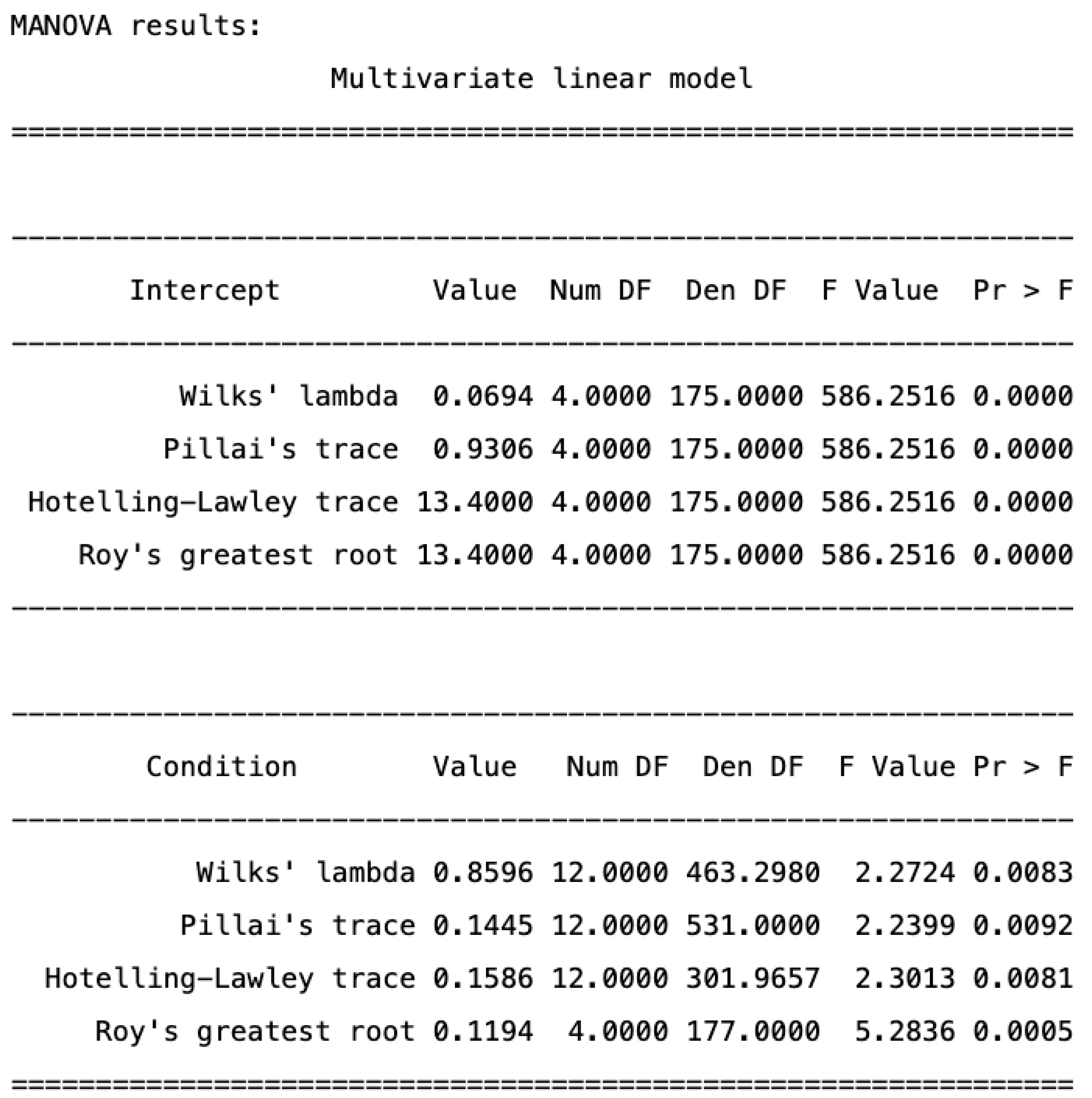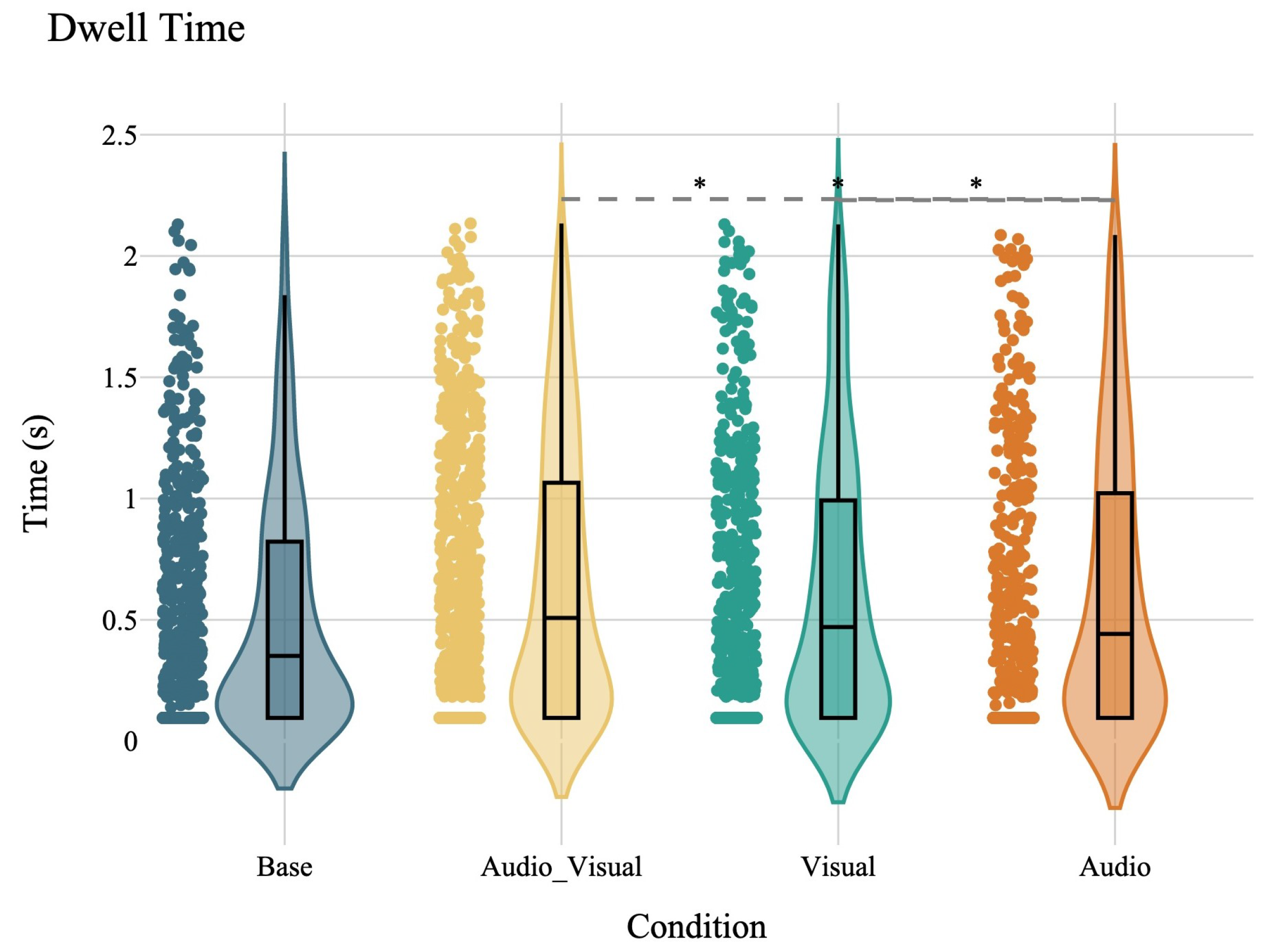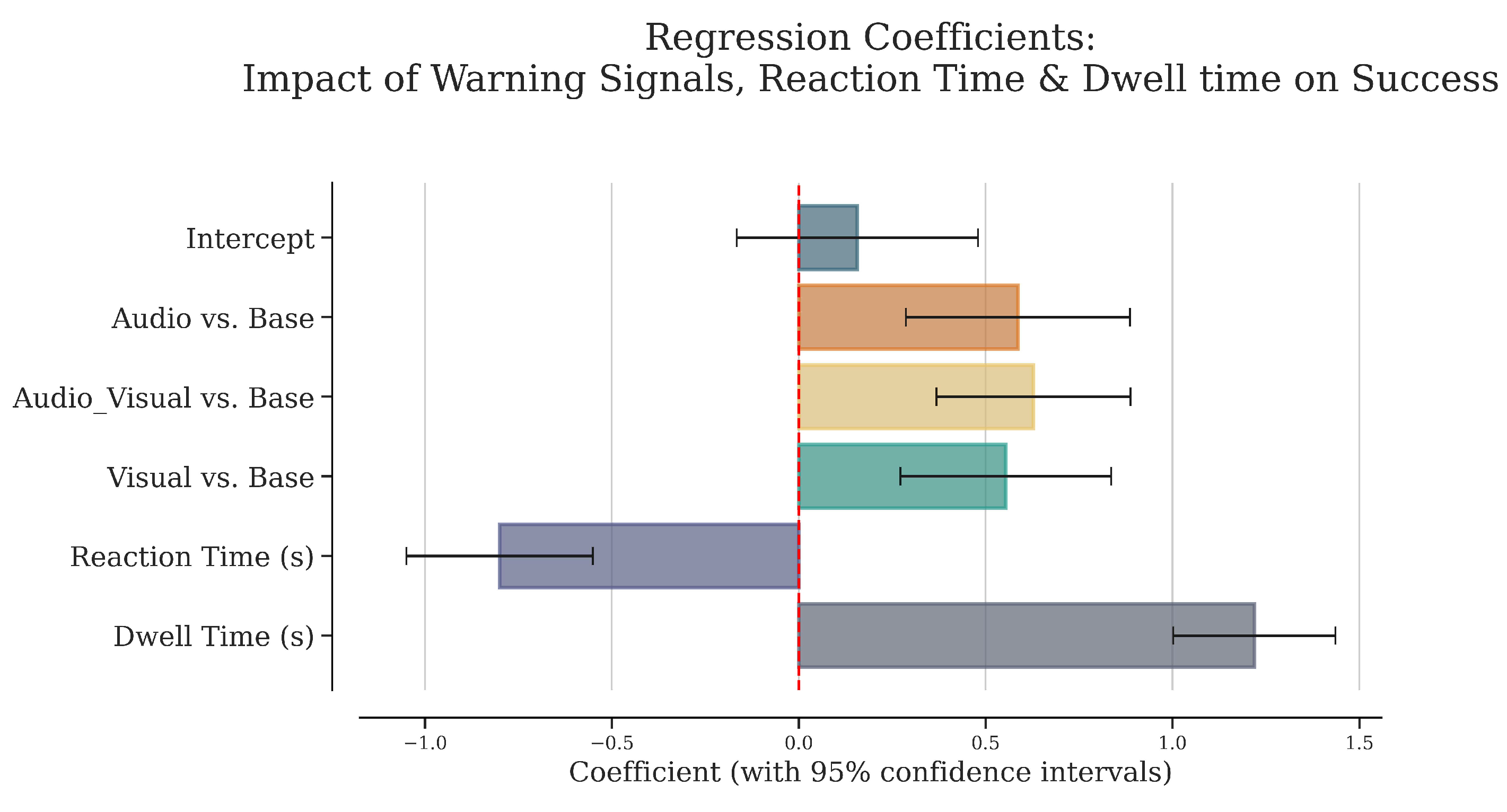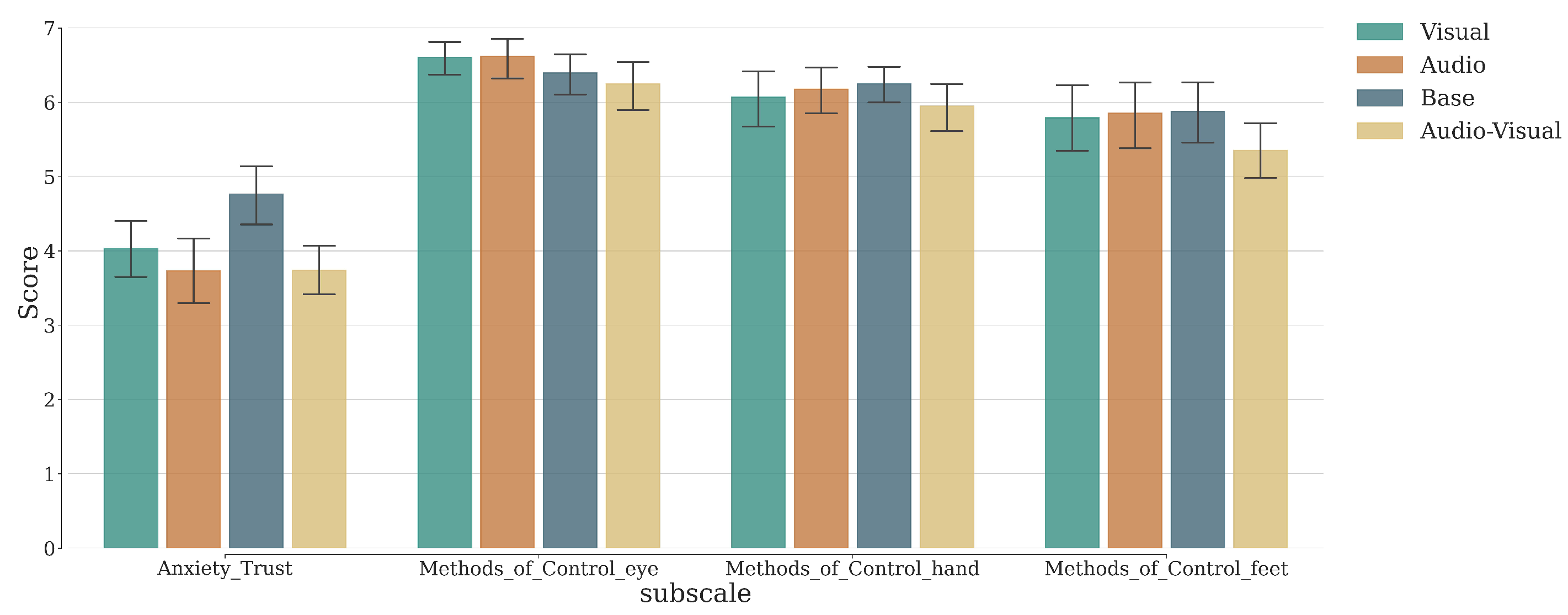Enhancing Safety in Autonomous Vehicles: The Impact of Auditory and Visual Warning Signals on Driver Behavior and Situational Awareness
Abstract
1. Introduction
1.1. Background
1.2. Research Aim
2. Materials and Methods
2.1. Research Design
2.2. Materials and Setup
2.3. Participants
2.4. Experimental Procedure
2.5. Data Preprocessing
2.6. Performance Metrics
2.6.1. Reaction Times
2.6.2. Situational Awareness
2.6.3. Successful Maneuvering
3. Results
3.1. Reaction Time Analysis
3.2. Synergy between Warning Signals and Seeing Objects of Interest
3.3. Dwell Time of Gaze Analysis
3.4. Identifying Success Factors in Critical Event Maneuvering
3.5. Questionnaire Analysis
Questionnaire and Behavioral Data Comparison
4. Discussion
5. Conclusions
Author Contributions
Funding
Institutional Review Board Statement
Informed Consent Statement
Data Availability Statement
Acknowledgments
Conflicts of Interest
Abbreviations
| AVs | Autonomous Vehicles |
| VR | Virtual Reality |
| HMIs | Human–Machine Interfaces |
| HMD | Head-Mounted Display |
| SAE | Society of Automotive Engineers |
| NDRTs | Non-Driving-related Tasks |
| TORs | Take-over Requests |
| ANOVA | Analysis of Variance |
| MANOVA | Multivariate Analysis of Variance |
| AVAM | Autonomous Vehicle Acceptance Model |
| M | mean |
| Standard Deviation | |
| Chi-square | |
| W | Wilcoxon signed-rank test statistic |
| p | p-value (probability value) |
| Beta coefficient (regression coefficient) | |
| SE | Standard Error |
| z | z-score (standard score) |
| LLR | Log-Likelihood Ratio |
| Pseudo R-squared (indicating the goodness-of-fit for logistic regression) | |
| F | F-statistic |
| Wilks’ Lambda (statistic for MANOVA) | |
| V | Pillai’s Trace (statistic for MANOVA) |
| Hotelling–Lawley Trace (statistic for MANOVA) | |
| Roy’s Greatest Root (statistic for MANOVA) | |
| Tukey’s HSD | Tukey’s Honestly Significant Difference |
Appendix A. Questionnaire Subset
| Question Text |
|---|
| Anxiety |
| 19. I would have concerns about using the vehicle. |
| 20. The vehicle could do something frightening to me. |
| 21. I am afraid that I would not understand the vehicle. |
| Perceived Safety |
| 24. I believe that using the vehicle would be dangerous. |
| 25. I would feel safe while using the vehicle. |
| 26. I would trust the vehicle. |
| Methods of Control: How important would each of the following be when using the vehicle? |
| 1. Hands |
| 2. Feet |
| 3. Eyes |




References
- Bazilinskyy, P.; Sakuma, T.; de Winter, J. What driving style makes pedestrians think a passing vehicle is driving automatically? Appl. Ergon. 2021, 95, 103428. [Google Scholar] [CrossRef] [PubMed]
- Sourelli, A.M.; Welsh, R.; Thomas, P. User preferences, driving context or manoeuvre characteristics? Exploring parameters affecting the acceptability of automated overtaking. Appl. Ergon. 2023, 109, 103959. [Google Scholar] [CrossRef] [PubMed]
- Zhang, Y.; Ma, Q.; Qu, J.; Zhou, R. Effects of driving style on takeover performance during automated driving: Under the influence of warning system factors. Appl. Ergon. 2024, 117, 104229. [Google Scholar] [CrossRef]
- Zhang, Y.; Zhou, X.; Wang, W.; Hu, Y.; Sun, X. Keeping in the lane! Investigating drivers’ performance handling silent vs. alerted lateral control failures in monotonous partially automated driving. Int. J. Ind. Ergon. 2023, 95, 103429. [Google Scholar] [CrossRef]
- Taxonomy and Definitions for Terms Related to Driving Automation Systems for on-Road Motor Vehicles; SAE International: Warrendale, PA, USA, 2021; Available online: https://www.sae.org/standards/content/j3016_202104/ (accessed on 18 July 2024).
- Rödel, C.; Stadler, S.; Meschtscherjakov, A.; Tscheligi, M. Towards autonomous cars: The effect of autonomy levels on acceptance and user experience. In Proceedings of the 6th International Conference on Automotive User Interfaces and Interactive Vehicular Applications, Seattle, WA, USA, 17–19 September 2014; pp. 1–8. [Google Scholar] [CrossRef]
- Sentouh, C.; Nguyen, A.T.; Benloucif, M.A.; Popieul, J.C. Driver-automation cooperation oriented approach for shared control of lane keeping assist systems. IEEE Trans. Control Syst. Technol. 2019, 27, 1962–1978. [Google Scholar] [CrossRef]
- Derakhshan, S.; Nosrat Nezami, F.; Wächter, M.A.; Stephan, A.; Pipa, G.; König, P. A Situated Inspection of Autonomous Vehicle Acceptance–A Population Study in Virtual Reality. Int. J. Hum.—Comput. Interact. 2024, 1–20. [Google Scholar] [CrossRef]
- Körber, M.; Prasch, L.; Bengler, K. Why do I have to drive now? Post hoc explanations of takeover requests. Hum. Factors 2018, 60, 305–323. [Google Scholar] [CrossRef]
- Mara, M.; Meyer, K. Acceptance of autonomous vehicles: An overview of user-specific, car-specific and contextual determinants. In User Experience Design in the Era of Automated Driving; Springer: Berlin/Heidelberg, Germany, 2022; pp. 51–83. [Google Scholar] [CrossRef]
- Zhang, T.; Tao, D.; Qu, X.; Zhang, X.; Zeng, J.; Zhu, H.; Zhu, H. Automated vehicle acceptance in China: Social influence and initial trust are key determinants. Transp. Res. Part C Emerg. Technol. 2020, 112, 220–233. [Google Scholar] [CrossRef]
- Capallera, M.; Meteier, Q.; De Salis, E.; Widmer, M.; Angelini, L.; Carrino, S.; Sonderegger, A.; Abou Khaled, O.; Mugellini, E. A contextual multimodal system for increasing situation awareness and takeover quality in conditionally automated driving. IEEE Access 2023, 11, 5746–5771. [Google Scholar] [CrossRef]
- Kyriakidis, M.; Happee, R.; De Winter, J.C. Public opinion on automated driving: Results of an international questionnaire among 5000 respondents. Transp. Res. Part F Traffic Psychol. Behav. 2015, 32, 127–140. [Google Scholar] [CrossRef]
- Merat, N.; Seppelt, B.; Louw, T.; Engström, J.; Lee, J.D.; Johansson, E.; Green, C.A.; Katazaki, S.; Monk, C.; Itoh, M.; et al. The “Out-of-the-Loop” concept in automated driving: Proposed definition, measures and implications. Cogn. Technol. Work 2019, 21, 87–98. [Google Scholar] [CrossRef]
- Mole, C.D.; Lappi, O.; Giles, O.; Markkula, G.; Mars, F.; Wilkie, R.M. Getting back into the loop: The perceptual-motor determinants of successful transitions out of automated driving. Hum. Factors 2019, 61, 1037–1065. [Google Scholar] [CrossRef] [PubMed]
- Dillmann, J.; den Hartigh, R.; Kurpiers, C.; Pelzer, J.; Raisch, F.; Cox, R.; De Waard, D. Keeping the driver in the loop through semi-automated or manual lane changes in conditionally automated driving. Accid. Anal. Prev. 2021, 162, 106397. [Google Scholar] [CrossRef] [PubMed]
- Dillmann, J.; Den Hartigh, R.; Kurpiers, C.; Raisch, F.; De Waard, D.; Cox, R. Keeping the driver in the loop in conditionally automated driving: A perception-action theory approach. Transp. Res. Part F Traffic Psychol. Behav. 2021, 79, 49–62. [Google Scholar] [CrossRef]
- Weaver, B.W.; DeLucia, P.R. A systematic review and meta-analysis of takeover performance during conditionally automated driving. Hum. Factors 2022, 64, 1227–1260. [Google Scholar] [CrossRef]
- Zhang, B.; De Winter, J.; Varotto, S.; Happee, R.; Martens, M. Determinants of take-over time from automated driving: A meta-analysis of 129 studies. Transp. Res. Part F Traffic Psychol. Behav. 2019, 64, 285–307. [Google Scholar] [CrossRef]
- Liu, W.; Li, Q.; Wang, Z.; Wang, W.; Zeng, C.; Cheng, B. A literature review on additional semantic information conveyed from driving automation systems to drivers through advanced in-vehicle hmi just before, during, and right after takeover request. Int. J. Hum.-Interact. 2023, 39, 1995–2015. [Google Scholar] [CrossRef]
- Baldwin, C.L.; Spence, C.; Bliss, J.P.; Brill, J.C.; Wogalter, M.S.; Mayhorn, C.B.; Ferris, T.K. Multimodal cueing: The relative benefits of the auditory, visual, and tactile channels in complex environments. In Proceedings of the Human Factors and Ergonomics Society Annual Meeting, Boston, MA, USA, 22–26 October 2012; SAGE Publications Sage CA: Los Angeles, CA, USA, 2012; Volume 56, pp. 1431–1435. [Google Scholar] [CrossRef]
- Cohen-Lazry, G.; Katzman, N.; Borowsky, A.; Oron-Gilad, T. Directional tactile alerts for take-over requests in highly-automated driving. Transp. Res. Part F Traffic Psychol. Behav. 2019, 65, 217–226. [Google Scholar] [CrossRef]
- Gold, C.; Damböck, D.; Lorenz, L.; Bengler, K. “Take over!” How long does it take to get the driver back into the loop? In Proceedings of the Human Factors and Ergonomics Society Annual Meeting, San Diego, CA, USA, 30 September–4 October 2013; Sage Publications Sage CA: Los Angeles, CA, USA, 2013; Volume 57, pp. 1938–1942. [Google Scholar] [CrossRef]
- Zhang, B.; Wilschut, E.S.; Willemsen, D.M.; Martens, M.H. Transitions to manual control from highly automated driving in non-critical truck platooning scenarios. Transp. Res. Part F Traffic Psychol. Behav. 2019, 64, 84–97. [Google Scholar] [CrossRef]
- Endsley, M.R. Toward a theory of situation awareness in dynamic systems. Hum. Factors 1995, 37, 32–64. [Google Scholar] [CrossRef]
- Park, Y.; Ji, J.; Kang, H. Effect of a looming visual cue on situation awareness and perceived urgency in response to a takeover request. Heliyon 2024, 10, e23053. [Google Scholar] [CrossRef] [PubMed]
- Houtenbos, M.; de Winter, J.C.; Hale, A.R.; Wieringa, P.A.; Hagenzieker, M.P. Concurrent audio–visual feedback for supporting drivers at intersections: A study using two linked driving simulators. Appl. Ergon. 2017, 60, 30–42. [Google Scholar] [CrossRef]
- Naujoks, F.; Mai, C.; Neukum, A. The Effect of Urgency of Take-Over Requests During Highly Automated Driving Under Distraction Conditions. In Proceedings of the Advances in Human Aspects of Transportation: Part I, AHFE, Virtual. 25–29 July 2021. [Google Scholar] [CrossRef]
- Sanghavi, H.; Zhang, Y.; Jeon, M. Exploring the influence of driver affective state and auditory display urgency on takeover performance in semi-automated vehicles: Experiment and modelling. Int. J. Hum.-Comput. Stud. 2023, 171, 102979. [Google Scholar] [CrossRef]
- Brandenburg, S.; Chuang, L. Take-over requests during highly automated driving: How should they be presented and under what conditions? Transp. Res. Part F Traffic Psychol. Behav. 2019, 66, 214–225. [Google Scholar] [CrossRef]
- Zeeb, K.; Buchner, A.; Schrauf, M. Is take-over time all that matters? The impact of visual-cognitive load on driver take-over quality after conditionally automated driving. Accid. Anal. Prev. 2016, 92, 230–239. [Google Scholar] [CrossRef]
- Bazilinskyy, P.; Petermeijer, S.M.; Petrovych, V.; Dodou, D.; de Winter, J.C. Take-over requests in highly automated driving: A crowdsourcing survey on auditory, vibrotactile, and visual displays. Transp. Res. Part F Traffic Psychol. Behav. 2018, 56, 82–98. [Google Scholar] [CrossRef]
- Cao, Y.; Zhou, F.; Pulver, E.M.; Molnar, L.J.; Robert, L.P.; Tilbury, D.M.; Yang, X.J. Towards standardized metrics for measuring takeover performance in conditionally automated driving: A systematic review. In Proceedings of the Human Factors and Ergonomics Society Annual Meeting, Baltimore, MD, USA, 4–7 October 2021; SAGE Publications Sage CA: Los Angeles, CA, USA, 2021; Volume 65, pp. 1065–1069. [Google Scholar] [CrossRef]
- Riegler, A.; Riener, A.; Holzmann, C. A systematic review of virtual reality applications for automated driving: 2009–2020. Front. Hum. Dyn. 2021, 3, 689856. [Google Scholar] [CrossRef]
- Gold, C.; Happee, R.; Bengler, K. Modeling take-over performance in level 3 conditionally automated vehicles. Accid. Anal. Prev. 2018, 116, 3–13. [Google Scholar] [CrossRef]
- Zhou, F.; Yang, X.J.; De Winter, J.C. Using eye-tracking data to predict situation awareness in real time during takeover transitions in conditionally automated driving. IEEE Trans. Intell. Transp. Syst. 2022, 23, 2284–2295. [Google Scholar] [CrossRef]
- Fouladinejad, N.; Fouladinejad, N.; Abd Jalil, M.; Taib, J.M. Modeling virtual driving environment for a driving simulator. In Proceedings of the 2011 IEEE International Conference on Control System, Computing and Engineering, Penang, Malaysia, 25–27 November 2011; pp. 27–32. [Google Scholar] [CrossRef]
- Wilkinson, M.; Brown, T.; Ahmad, O. The national advanced driving simulator (NADS) description and capabilities in vision-related research. Optometry 2012, 83, 285–288. [Google Scholar]
- Ho, C.; Gray, R.; Spence, C. To what extent do the findings of laboratory-based spatial attention research apply to the real-world setting of driving? IEEE Trans. Hum.-Mach. Syst. 2014, 44, 524–530. [Google Scholar] [CrossRef]
- Weiss, E.; Talbot, J.; Gerdes, J.C. Combining virtual reality and steer-by-wire systems to validate driver assistance concepts. In Proceedings of the 2022 IEEE Intelligent Vehicles Symposium (IV), Aachen, Germany, 5–9 June 2022; pp. 1709–1715. [Google Scholar] [CrossRef]
- Morra, L.; Lamberti, F.; Pratticó, F.G.; La Rosa, S.; Montuschi, P. Building trust in autonomous vehicles: Role of virtual reality driving simulators in HMI design. IEEE Trans. Veh. Technol. 2019, 68, 9438–9450. [Google Scholar] [CrossRef]
- Feliciani, C.; Crociani, L.; Gorrini, A.; Nagahama, A.; Nishinari, K.; Bandini, S. Experiments and Usability Tests of a VR-Based Driving Simulator to Evaluate Driving Behavior in the Presence of Crossing Pedestrians. In Traffic and Granular Flow 2019; Springer: Berlin/Heidelberg, Germany, 2020; pp. 471–477. [Google Scholar] [CrossRef]
- Le, D.H.; Temme, G.; Oehl, M. Automotive eHMI Development in Virtual Reality: Lessons Learned from Current Studies. In Proceedings of the HCI International 2020–Late Breaking Posters: 22nd International Conference, HCII 2020, Copenhagen, Denmark, 19–24 July 2020; Proceedings, Part II 22. Springer: Berlin/Heidelberg, Germany, 2020; pp. 593–600. [Google Scholar] [CrossRef]
- Sportillo, D.; Paljic, A.; Ojeda, L. Get ready for automated driving using virtual reality. Accid. Anal. Prev. 2018, 118, 102–113. [Google Scholar] [CrossRef] [PubMed]
- Eudave, L.; Valencia, M. Physiological response while driving in an immersive virtual environment. In Proceedings of the 2017 IEEE 14th International Conference on Wearable and Implantable Body Sensor Networks (BSN), Eindhoven, The Netherlands, 9–12 May 2017; pp. 145–148. [Google Scholar] [CrossRef]
- Vaitheeshwari, R.; Yeh, S.C.; Wu, E.H.K.; Chen, J.Y.; Chung, C.R. Stress recognition based on multiphysiological data in high-pressure driving VR scene. IEEE Sens. J. 2022, 22, 19897–19907. [Google Scholar] [CrossRef]
- Ihemedu-Steinke, Q.C.; Erbach, R.; Halady, P.; Meixner, G.; Weber, M. Virtual reality driving simulator based on Head-Mounted Displays. In Automotive User Interfaces: Creating Interactive Experiences in the Car; Springer: Berlin/Heidelberg, Germany, 2017; pp. 401–428. [Google Scholar] [CrossRef]
- Yeo, D.; Kim, G.; Kim, S. Toward immersive self-driving simulations: Reports from a user study across six platforms. In Proceedings of the 2020 CHI Conference on Human Factors in Computing Systems, Honolulu, HI, USA, 25–30 April 2020; pp. 1–12. [Google Scholar] [CrossRef]
- Adhanom, I.B.; MacNeilage, P.; Folmer, E. Eye tracking in virtual reality: A broad review of applications and challenges. Virtual Real. 2023, 27, 1481–1505. [Google Scholar] [CrossRef]
- Wang, Y.; Zhang, W.; Wu, S.; Guo, Y. Simulators for driving safety study—A literature review. In Proceedings of the Virtual Reality: Second International Conference, ICVR 2007, Held as Part of HCI International 2007, Beijing, China, 22–27 July 2007; Proceedings 2. Springer: Berlin/Heidelberg, Germany, 2007; pp. 584–593. [Google Scholar] [CrossRef]
- Kanade, S.G.; Duffy, V.G. Use of virtual reality for safety training: A systematic review. In Proceedings of the International Conference on Human-Computer Interaction, Virtual. 26 June–1 July 2022; Springer: Berlin/Heidelberg, Germany, 2022; pp. 364–375. [Google Scholar] [CrossRef]
- Stefan, H.; Mortimer, M.; Horan, B. Evaluating the effectiveness of virtual reality for safety-relevant training: A systematic review. Virtual Real. 2023, 27, 2839–2869. [Google Scholar] [CrossRef]
- Zhao, J.; Xu, X.; Jiang, H.; Ding, Y. The effectiveness of virtual reality-based technology on anatomy teaching: A meta-analysis of randomized controlled studies. BMC Med Educ. 2020, 20, 127. [Google Scholar] [CrossRef]
- Hewitt, C.; Politis, I.; Amanatidis, T.; Sarkar, A. Assessing public perception of self-driving cars: The autonomous vehicle acceptance model. In Proceedings of the 24th International Conference on Intelligent User Interfaces, Marina del Ray, CA, USA, 16–20 March 2019; pp. 518–527. [Google Scholar] [CrossRef]
- Unity 3D. Unity Technologies. 2024. Available online: https://unity.com (accessed on 13 July 2024).
- Nezami, F.N.; Wächter, M.A.; Maleki, N.; Spaniol, P.; Kühne, L.M.; Haas, A.; Pingel, J.M.; Tiemann, L.; Nienhaus, F.; Keller, L.; et al. Westdrive X LoopAR: An Open-Access Virtual Reality Project in Unity for Evaluating User Interaction Methods during Takeover Requests. Sensors 2021, 21, 1879. [Google Scholar] [CrossRef]
- Funkhouser, K.; Drews, F. Reaction times when switching from autonomous to manual driving control: A pilot investigation. In Proceedings of the Human Factors and Ergonomics Society Annual Meeting, Washington, DC, USA, 19–23 September 2016; SAGE Publications Sage CA: Los Angeles, CA, USA, 2016; Volume 60, pp. 1854–1858. [Google Scholar] [CrossRef]
- Schmidt, K.; Beggiato, M.; Hoffmann, K.H.; Krems, J.F. A mathematical model for predicting lane changes using the steering wheel angle. J. Saf. Res. 2014, 49, 85.e1–90.e1. [Google Scholar] [CrossRef]
- Lv, C.; Li, Y.; Xing, Y.; Huang, C.; Cao, D.; Zhao, Y.; Liu, Y. Human–Machine Collaboration for Automated Driving Using an Intelligent Two-Phase Haptic Interface. Adv. Intell. Syst. 2021, 3, 2000229. [Google Scholar] [CrossRef]
- Salvucci, D.D.; Goldberg, J.H. Identifying fixations and saccades in eye-tracking protocols. In Proceedings of the 2000 Symposium on Eye Tracking Research & Applications, Palm Beach Gardens, FL, USA, 6–8 November 2000; pp. 71–78. [Google Scholar] [CrossRef]
- Voloh, B.; Watson, M.R.; König, S.; Womelsdorf, T. MAD saccade: Statistically robust saccade threshold estimation via the median absolute deviation. J. Eye Mov. Res. 2019, 12. [Google Scholar] [CrossRef]
- Chang, E.; Kim, H.T.; Yoo, B. Virtual reality sickness: A review of causes and measurements. Int. J. Hum.-Interact. 2020, 36, 1658–1682. [Google Scholar] [CrossRef]
- Borojeni, S.S.; Chuang, L.; Heuten, W.; Boll, S. Assisting drivers with ambient take-over requests in highly automated driving. In Proceedings of the 8th International Conference on Automotive User Interfaces and Interactive Vehicular Applications, Ann Arbor, MI, USA, 24–26 October 2016; pp. 237–244. [Google Scholar] [CrossRef]
- Politis, I.; Brewster, S.; Pollick, F. Language-based multimodal displays for the handover of control in autonomous cars. In Proceedings of the 7th International Conference on Automotive User Interfaces and Interactive Vehicular Applications, Nottingham, UK, 1–3 September 2015; pp. 3–10. [Google Scholar] [CrossRef]
- Melcher, V.; Rauh, S.; Diederichs, F.; Widlroither, H.; Bauer, W. Take-over requests for automated driving. Procedia Manuf. 2015, 3, 2867–2873. [Google Scholar] [CrossRef]
- Liang, N.; Yang, J.; Yu, D.; Prakah-Asante, K.O.; Curry, R.; Blommer, M.; Swaminathan, R.; Pitts, B.J. Using eye-tracking to investigate the effects of pre-takeover visual engagement on situation awareness during automated driving. Accid. Anal. Prev. 2021, 157, 106143. [Google Scholar] [CrossRef]
- Kim, S.; van Egmond, R.; Happee, R. Effects of user interfaces on take-over performance: A review of the empirical evidence. Information 2021, 12, 162. [Google Scholar] [CrossRef]
- Ayoub, J.; Avetisian, L.; Yang, X.J.; Zhou, F. Real-time trust prediction in conditionally automated driving using physiological measures. IEEE Trans. Intell. Transp. Syst. 2023, 24, 14642–14650. [Google Scholar] [CrossRef]
- Winter, J.D.; Stanton, N.A.; Price, J.S.; Mistry, H. The effects of driving with different levels of unreliable automation on self-reported workload and secondary task performance. Int. J. Veh. Des. 2016, 70, 297–324. [Google Scholar] [CrossRef]
- Endsley, M.R. From here to autonomy: Lessons learned from human–automation research. Hum. Factors 2017, 59, 5–27. [Google Scholar] [CrossRef] [PubMed]
- Baldwin, C.L.; Lewis, B.A. Perceived urgency mapping across modalities within a driving context. Appl. Ergon. 2014, 45, 1270–1277. [Google Scholar] [CrossRef]
- Li, Q.; Wang, Z.; Wang, W.; Zeng, C.; Li, G.; Yuan, Q.; Cheng, B. An adaptive time budget adjustment strategy based on a take-over performance model for passive fatigue. IEEE Trans. Hum.-Mach. Syst. 2021, 52, 1025–1035. [Google Scholar] [CrossRef]










| Dimension | Items | Factor | Communality | |
|---|---|---|---|---|
| 1 | 2 | |||
| Anxiety_Trust | Anxiety_1 | 0.77 | 0.11 | 0.60 |
| Anxiety_2 | 0.66 | −0.12 | 0.45 | |
| Anxiety_3 | 0.45 | −0.01 | 0.20 | |
| Perceived_safety_1 | 0.78 | −0.00 | 0.61 | |
| Perceived_safety_2 | −0.78 | −0.12 | 0.62 | |
| Perceived_safety_3 | −0.69 | −0.05 | 0.47 | |
| Methods of Control | Eye | 0.02 | 0.38 | 0.15 |
| Hand | 0.03 | 0.66 | 0.44 | |
| Feet | 0.00 | 0.57 | 0.32 | |
Disclaimer/Publisher’s Note: The statements, opinions and data contained in all publications are solely those of the individual author(s) and contributor(s) and not of MDPI and/or the editor(s). MDPI and/or the editor(s) disclaim responsibility for any injury to people or property resulting from any ideas, methods, instructions or products referred to in the content. |
© 2024 by the authors. Licensee MDPI, Basel, Switzerland. This article is an open access article distributed under the terms and conditions of the Creative Commons Attribution (CC BY) license (https://creativecommons.org/licenses/by/4.0/).
Share and Cite
Huang, A.; Derakhshan, S.; Madrid-Carvajal, J.; Nosrat Nezami, F.; Wächter, M.A.; Pipa, G.; König, P. Enhancing Safety in Autonomous Vehicles: The Impact of Auditory and Visual Warning Signals on Driver Behavior and Situational Awareness. Vehicles 2024, 6, 1613-1636. https://doi.org/10.3390/vehicles6030076
Huang A, Derakhshan S, Madrid-Carvajal J, Nosrat Nezami F, Wächter MA, Pipa G, König P. Enhancing Safety in Autonomous Vehicles: The Impact of Auditory and Visual Warning Signals on Driver Behavior and Situational Awareness. Vehicles. 2024; 6(3):1613-1636. https://doi.org/10.3390/vehicles6030076
Chicago/Turabian StyleHuang, Ann, Shadi Derakhshan, John Madrid-Carvajal, Farbod Nosrat Nezami, Maximilian Alexander Wächter, Gordon Pipa, and Peter König. 2024. "Enhancing Safety in Autonomous Vehicles: The Impact of Auditory and Visual Warning Signals on Driver Behavior and Situational Awareness" Vehicles 6, no. 3: 1613-1636. https://doi.org/10.3390/vehicles6030076
APA StyleHuang, A., Derakhshan, S., Madrid-Carvajal, J., Nosrat Nezami, F., Wächter, M. A., Pipa, G., & König, P. (2024). Enhancing Safety in Autonomous Vehicles: The Impact of Auditory and Visual Warning Signals on Driver Behavior and Situational Awareness. Vehicles, 6(3), 1613-1636. https://doi.org/10.3390/vehicles6030076









